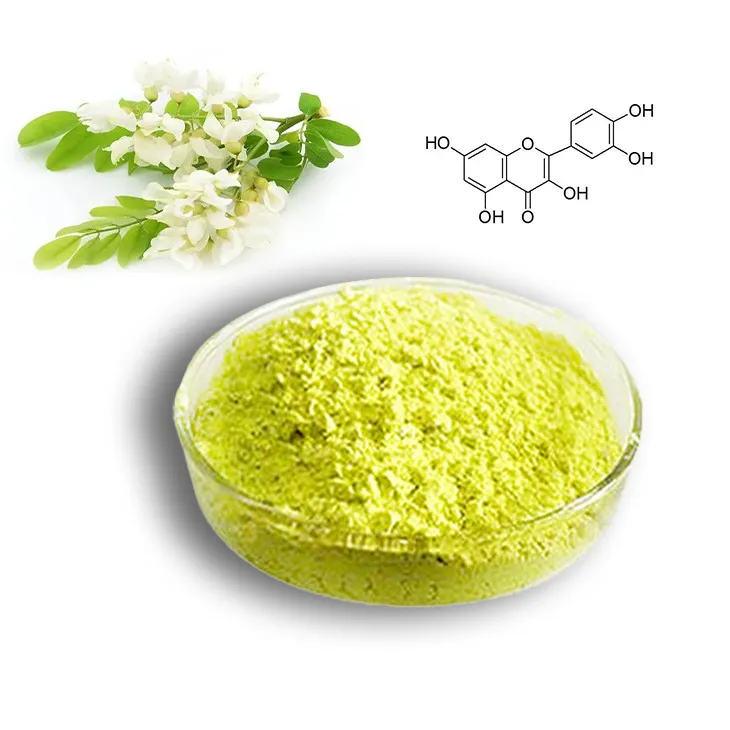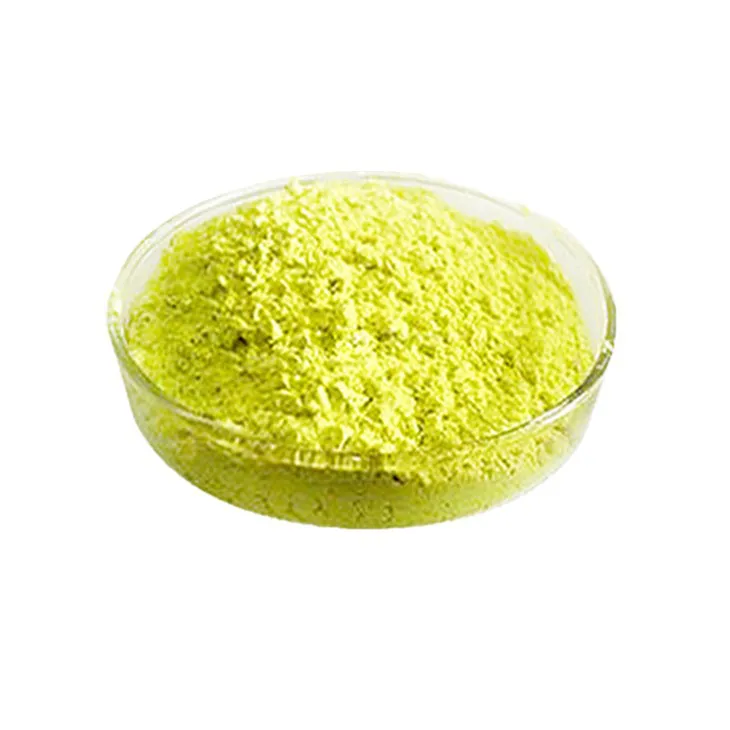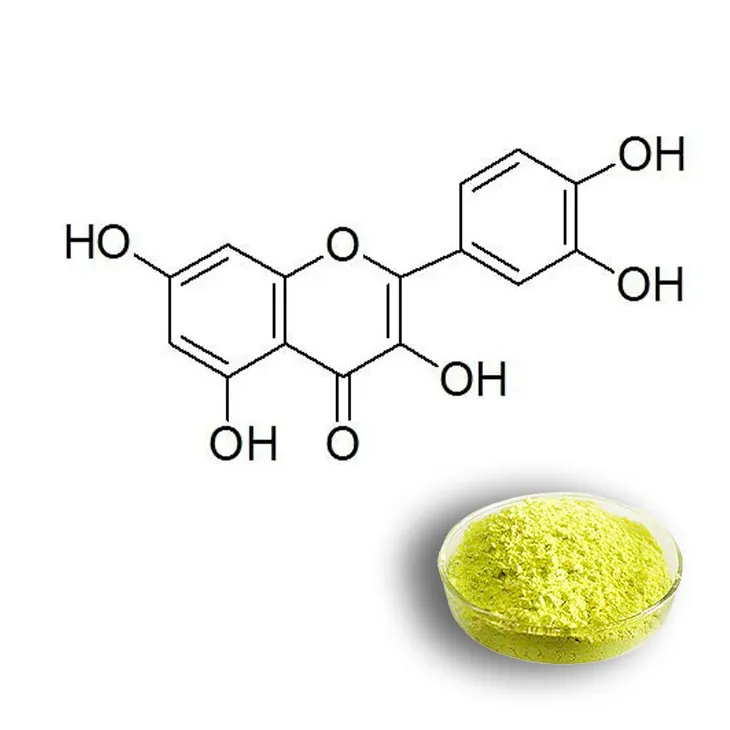- 0086-571-85302990
- sales@greenskybio.com
Quercetin Suppliers
2024-11-30

1. Introduction to Quercetin and its Market Significance
Quercetin, a flavonoid found in various fruits, vegetables, and grains, has gained significant attention in the health - related product market. It is known for its antioxidant, anti - inflammatory, and potential health - promoting properties. As a result, the demand for Quercetin - based products has been steadily increasing. In this context, quercetin suppliers play a vital role in ensuring the availability of this important compound for different applications.

2. Production Capacity of Quercetin Suppliers
A reliable quercetin supplier must possess a strong production capacity. This capacity is crucial as it determines their ability to meet diverse market demands.
2.1 Meeting Small - scale Research Needs
For small - scale research projects, a consistent supply of quercetin is essential. Researchers may require precise amounts of quercetin for in - vitro studies, animal trials, or preliminary human clinical trials. Suppliers need to be able to provide high - quality quercetin in quantities that are suitable for these research activities. This may involve having the necessary laboratory - scale production facilities or the ability to accurately portion out larger batches for research purposes.
2.2 Catering to Large - scale Commercial Production
On the other hand, the market also has a significant demand for quercetin in large - scale commercial production of health - related products. These products can range from dietary supplements in the form of capsules, tablets, or powders to functional foods and beverages that contain quercetin. Suppliers with a large production capacity can ensure a continuous supply of quercetin to manufacturers of these products. They need to have industrial - scale production plants, efficient manufacturing processes, and quality control systems in place to meet the high - volume demands of the commercial market.

3. Research and Development Efforts by Quercetin Suppliers
Some leading quercetin suppliers are actively engaged in research and development (R & D) activities.
3.1 Improving Bioavailability
One of the key areas of R & D is improving the bioavailability of quercetin. Quercetin has relatively low bioavailability in its natural form, which means that only a small fraction of the ingested quercetin is actually absorbed and utilized by the body. Suppliers are exploring various strategies to enhance this bioavailability.
Some are investing in research to develop better formulations of quercetin. For example, they may be investigating the use of nano - technology to encapsulate quercetin molecules. Nano - encapsulation can protect quercetin from degradation in the digestive system and improve its solubility, thereby increasing its absorption. Another approach could be the development of lipid - based formulations, as lipids can enhance the absorption of lipophilic compounds like quercetin.
3.2 Combination with Other Substances
Suppliers are also looking into combining quercetin with other substances to enhance its absorption and effectiveness in the body. For instance, combining quercetin with certain vitamins, such as vitamin C, may have a synergistic effect. Vitamin C can help to maintain the stability of quercetin and may also influence its transport across cell membranes. Additionally, some research suggests that combining quercetin with piperine (a compound found in black pepper) can significantly increase its bioavailability. Piperine has been shown to inhibit certain enzymes in the digestive system that are responsible for metabolizing quercetin, allowing more of it to be absorbed.

4. The Supply Chain of Quercetin Suppliers
The supply chain is a critical aspect of quercetin suppliers' operations.
4.1 Partnerships with Raw Material Providers
Quercetin suppliers need to have stable partnerships with raw material providers. The raw materials for quercetin production can come from various sources, such as plant extracts. For example, sources like onion skins, apples, and buckwheat are rich in quercetin. Suppliers must ensure that they have reliable access to these raw materials in sufficient quantities. This involves establishing long - term contracts with farmers or extractors who can provide high - quality plant materials. They also need to have quality control measures in place to ensure that the raw materials meet the required standards for quercetin production. For instance, the plant materials should be free from contaminants and have a consistent quercetin content.
4.2 Logistics and Global Distribution
Another important part of the supply chain is logistics. Quercetin suppliers need to work with logistics companies to ensure the timely and efficient distribution of their products. Since the demand for quercetin - based products is global, suppliers must be able to ship their products to different parts of the world without delay or disruption. This requires having a well - organized logistics network that can handle the storage, transportation, and delivery of quercetin products. They need to consider factors such as temperature control (as quercetin may be sensitive to certain environmental conditions), packaging integrity, and customs clearance in different countries. Additionally, suppliers may need to have regional distribution centers to reduce delivery times and costs.

5. Quality Control and Assurance in Quercetin Supply
Quality control is of utmost importance for quercetin suppliers.
5.1 Raw Material Quality
As mentioned earlier, ensuring the quality of raw materials is the first step in the quality control process. Suppliers need to conduct regular inspections and tests on the plant materials used for quercetin extraction. This includes testing for the presence of pesticides, heavy metals, and other contaminants. They should also verify the quercetin content in the raw materials to ensure that it meets the expected levels. Only high - quality raw materials can result in high - quality quercetin products.
5.2 Manufacturing Process Quality
During the manufacturing process, suppliers need to adhere to strict quality standards. This includes maintaining clean and hygienic production facilities, following Good Manufacturing Practice (GMP) guidelines. The manufacturing equipment should be regularly calibrated and maintained to ensure accurate production. Quality control checks should be carried out at various stages of the production process, such as during extraction, purification, and formulation. For example, in the extraction process, the efficiency of quercetin extraction should be monitored to ensure maximum yield while maintaining product quality. In the purification stage, the purity of the quercetin product should be verified to remove any unwanted impurities.
5.3 Final Product Testing
Before the quercetin products are released to the market, they need to undergo comprehensive final product testing. This includes testing for physical and chemical properties such as solubility, stability, and purity. Biological assays may also be conducted to assess the antioxidant and anti - inflammatory properties of the quercetin product. Only products that pass all these tests should be supplied to the market to ensure the safety and effectiveness of quercetin - based products for consumers.
6. Regulatory Compliance by Quercetin Suppliers
Quercetin suppliers must comply with relevant regulations.
6.1 Food and Dietary Supplement Regulations
Since quercetin is often used in food and dietary supplements, suppliers need to be aware of and comply with food and dietary supplement regulations in different countries. These regulations may cover aspects such as labeling requirements, maximum allowable levels of quercetin in products, and safety standards. For example, in the United States, the Food and Drug Administration (FDA) has specific regulations regarding dietary supplements, including requirements for ingredient listing, claims made on the label, and Good Manufacturing Practice compliance. Suppliers need to ensure that their products meet these regulations to avoid legal issues and to ensure consumer safety.
6.2 Pharmaceutical Regulations (if applicable)
In some cases, quercetin may be used in pharmaceutical products or in research related to pharmaceuticals. If so, suppliers need to comply with pharmaceutical regulations. These regulations are generally more stringent than those for food and dietary supplements. They may include requirements for pre - clinical and clinical trial approvals, drug manufacturing licenses, and strict quality control and safety assessment procedures. Suppliers involved in supplying quercetin for pharmaceutical applications need to have a thorough understanding of these regulations and ensure full compliance.
7. Market Competition among Quercetin Suppliers
The market for quercetin suppliers is highly competitive.
7.1 Pricing Strategies
One aspect of competition is pricing. Suppliers need to develop competitive pricing strategies to attract customers. This may involve finding ways to reduce production costs without sacrificing quality. For example, optimizing the supply chain to reduce raw material and logistics costs can help in offering more competitive prices. However, they also need to ensure that their pricing reflects the value of their quercetin products, taking into account factors such as quality, bioavailability, and research and development efforts.
7.2 Product Differentiation
Another way to compete is through product differentiation. Suppliers can offer unique formulations of quercetin, such as those with enhanced bioavailability or combined with other beneficial substances. They can also differentiate their products based on quality, such as offering higher - purity quercetin products. Additionally, providing excellent customer service, such as fast delivery, technical support for research customers, and responsive after - sales service, can also set a supplier apart from its competitors.
8. Future Trends in Quercetin Supply
Looking ahead, there are several trends that are likely to shape the future of quercetin supply.
8.1 Increasing Demand for Natural and Functional Ingredients
As consumers become more health - conscious and interested in natural and functional ingredients, the demand for quercetin is expected to continue to grow. This will require suppliers to expand their production capacities and improve their supply chains to meet the increasing market demands. They may also need to invest more in research and development to develop new and innovative quercetin - based products.
8.2 Sustainable Sourcing
There is also a growing trend towards sustainable sourcing of raw materials. Quercetin suppliers will need to ensure that their raw materials are sourced in an environmentally - friendly and sustainable manner. This could involve working with farmers who use sustainable agricultural practices, such as organic farming or reducing water and energy consumption in the extraction process. Sustainable sourcing not only meets the ethical and environmental concerns of consumers but can also be a competitive advantage in the market.
8.3 Technological Advancements
Advancements in technology are likely to play a significant role in the future of quercetin supply. New extraction techniques, such as supercritical fluid extraction, may improve the efficiency and quality of quercetin extraction. Nanotechnology and other innovative formulation technologies will continue to be explored to further enhance the bioavailability and effectiveness of quercetin products. Suppliers who can adapt and utilize these technological advancements will be better positioned in the market.
FAQ:
What are the key features of a reliable quercetin supplier?
A reliable quercetin supplier should have a strong production capacity to meet various market demands, from small - scale research projects to large - scale commercial production. They should also be active in research and development, for example, constantly exploring new ways to improve quercetin's bioavailability. Additionally, having a stable supply chain, including partnerships with raw material providers and logistics companies, is crucial.
Why is production capacity important for quercetin suppliers?
Production capacity is important because it enables the supplier to meet different levels of market demand. Whether it is for research purposes where small quantities might be needed or for large - scale commercial production of quercetin - containing products, a sufficient production capacity ensures that the market can be supplied adequately.
How do top - notch quercetin suppliers improve the bioavailability of quercetin?
Top - notch suppliers improve the bioavailability of quercetin by investing in research. They look for better formulations or combinations with other substances. These efforts are aimed at enhancing the absorption of quercetin in the human body.
What role does the supply chain play for quercetin suppliers?
The supply chain is very important for quercetin suppliers. Stable partnerships with raw material providers and logistics companies ensure a continuous supply of quercetin products to customers worldwide. This helps to avoid any delays or disruptions in the supply process.
How can customers ensure they choose a reliable quercetin supplier?
Customers can ensure they choose a reliable quercetin supplier by considering several factors. They can look at the supplier's production capacity to see if it can meet their needs. Research and development efforts are also a sign of a good supplier, as it shows their commitment to improving the product. Additionally, a stable supply chain is a positive indicator, so customers can inquire about the supplier's partnerships with raw material providers and logistics companies.
Related literature
- Quercetin: Sources, Bioavailability, and Emerging Roles in Health"
- "Quercetin in Health and Disease: Pharmacokinetic Properties and Drug - Delivery Strategies"
- ▶ Hesperidin
- ▶ citrus bioflavonoids
- ▶ plant extract
- ▶ lycopene
- ▶ Diosmin
- ▶ Grape seed extract
- ▶ Sea buckthorn Juice Powder
- ▶ Beetroot powder
- ▶ Hops Extract
- ▶ Artichoke Extract
- ▶ Reishi mushroom extract
- ▶ Astaxanthin
- ▶ Green Tea Extract
- ▶ Curcumin Extract
- ▶ Horse Chestnut Extract
- ▶ Other Problems
- ▶ Boswellia Serrata Extract
- ▶ Resveratrol Extract
- ▶ Marigold Extract
- ▶ Grape Leaf Extract
- ▶ blog3
- ▶ blog4
-
Ginger extract of the best quality.
2024-11-30
-
Wholesale Passion Fruit Extract Suppliers.
2024-11-30
-
Organic Genistein, Australia.
2024-11-30
-
Standard - process Nutmeg extract.
2024-11-30
-
Lemon Juice Powder
2024-11-30
-
Nutmeg Extract
2024-11-30
-
Alisma Extract
2024-11-30
-
Cat Claw Extract
2024-11-30
-
Longan Extract
2024-11-30
-
Calendula Extract
2024-11-30
-
Lycopene
2024-11-30
-
Red Date Extract
2024-11-30
-
Purple Sweet Potato Extract
2024-11-30
-
Kidney Bean Extract
2024-11-30





















